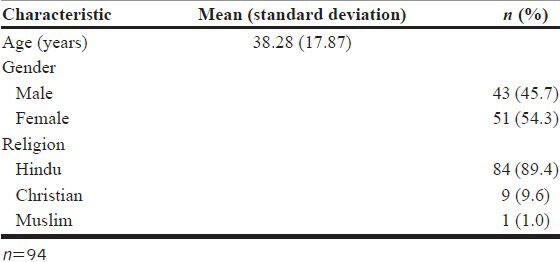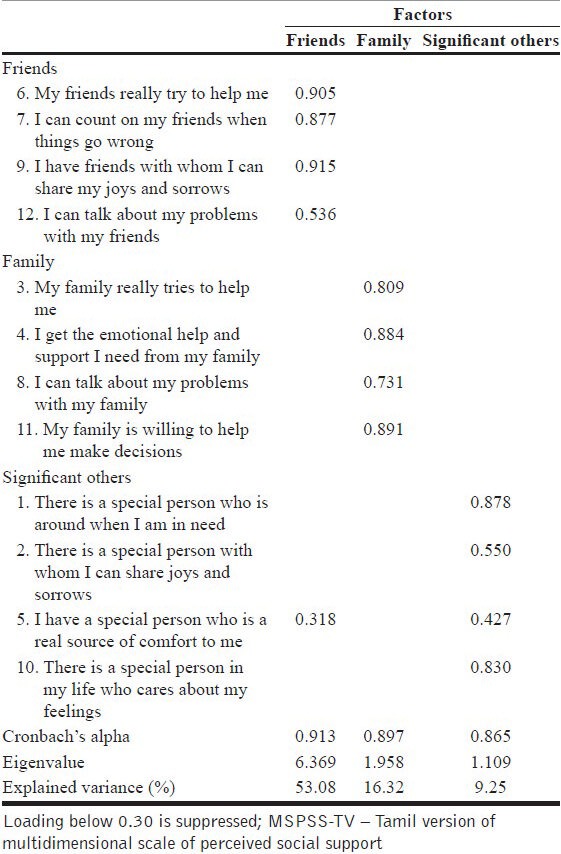Abstract
Background and Objectives:
This study was done to validate the Tamil version of Multidimensional Scale of Perceived Social Support (MSPSS-TV) among a group of Indian participants in University Malaya.
Materials and Methods:
Ninety-four people who took part in this study were given MSPSS-TV, Medical Outcome Study (MOS) social support survey, Malay version of Beck Depression Inventory (BDI), Malay version of General Health Questionnaire (GHQ), and English version of MSPSS. After a week, these participants were again required to complete the MSPSS-TV, but with the item sequences shuffled.
Results:
Internal consistency of this scale was excellent (Cronbach's alpha = 0.924), and both test-retest reliability (0.71) and parallel form reliability (0.92) were high (Spearman's rho, P<0.01). MSPSS-TV was negatively correlated with GHQ and BDI.
Interpretation and Conclusions:
The MSPSS-TV demonstrated sound psychometric properties in gauging the social support among a group of participants. It could therefore be used as a simple screening tool among the young educated Malaysians.
Keywords: Perceived social support, psychometric properties, reliability, Tamil version, validity
INTRODUCTION
Social support has received considerable amount of research attention of late. It is well-known that social support plays an integral part in the coping mechanism between stress and psychological or physical symptoms. There are in fact many methods available to measure social support, and Multidimensional Scale of Perceived Social Support (MSPSS) is one of the self-administered scales proven to be very useful in the assessment. The assessment of the three domains, that is, family, friends, and significant others, is used to determine the adequacy of social support. The assessment of social support is a multidimensional construct consisting of social network, emotional support, instrumental support, quality of social support, and reciprocal helping of one another.[1] The MSPSS is very simple to use as it contains only 12 items.[2] The scale has shown great reliability, validity, and factor structure over the years; even when tested on a wide range of samples including urban adolescents,[3] pregnant women,[4] adolescents living abroad,[2] university students,[5] adolescent psychiatric inpatients,[6] and outpatients.[7]
In the past, the scale had been translated into many other languages. Our main objective of this study is to translate the MSPSS into Tamil version (MSPSS-TV), and to examine the psychometric properties of the translated version among a group of Malaysian participants. We also focused on the reliability (internal consistency), concurrent and construct validities, factorial structure, and the specificity of the MSPSS-TV.
MATERIALS AND METHODS
Approval from the Medical Ethical Committee (MEC), University Malaya Medical Center was obtained to conduct the study. Permission from the original author of the instrument was obtained.
Stage 1
The English version of MSPSS was translated into Tamil by two doctors who were bilingual (Tamil and English). Another two doctors who were also bilingual then back-translated the Tamil version of MSPSS following the back-translation technique.[8]
Stage 2
The translated version was pilot tested among ten Indian employees at the Faculty of Medicine, University Malaya, Malaysia. Some items in the translated version needed minor revisions and were modified further. The finalized version was also reviewed by two Indian psychiatrists to ensure satisfactory face, semantic, criterion, and conceptual equivalence.[9]
Stage 3
Indian visitors and patients in University Malaya Medical Center were then approached for the validation study. Ninety-four subjects who agreed to participate successfully completed the study. They were given the following questionnaires: The MSPSS-TV, the Medical Outcome Study (MOS) social support survey, Malay version of BDI, and Malay version of GHQ.
As all the participants were bilingual (Malay and Tamil), they were given the Malay version of MSPSS immediately after the initial assessment.
Statistical analyses
The results were analyzed using the Statistical Package for Social Sciences version 13.0 (SPSS Inc, Chicago, IL, USA). The mean score of all items in MSPSS were calculated. Principle axis extraction approach with oblique rotation method was used to explore the correlation structure of the components. The Cronbach's alpha for all items and each components were calculated. The correlations between the total and each component of MSPSS with GHQ and BDI were analyzed with Spearman's test.
RESULTS
All the 94 participants gave informed consent to participate in this study. Their mean age was 38 years, with slightly more than half being females and majority (89.4%) of them being Hindu [Table 1].
Table 1.
Characteristics of the students

Factor analysis
The mean score of the respondents to the 12-item, 7-point Likert scale MSPSS-TV was in the direction of high social support (mean = 63.84, standard error (SE) =14.64). We conducted a confirmatory factor analysis of the MSPSS-TV items to confirm three factors’ structure proposed by the original authors in their original study.[2] In the study, correlation among three factors ranged from r = 0.38 (family with friends) to 0.63 (significant others with friends) [Table 2]. The Barlett's test of sphericity was significant (P<0.01) and the Kaiser-Meyer-Olkin measure of sampling adequacy for the 12 item MSPSS-TV was 0.83, which Kaiser reported as meritorious.[10] Therefore, it was appropriate to proceed to factor analysis. Factors were extracted with a common factor approach (principle axis extraction). Three factors were extracted (eigenvalue > 1.00) which coincides with the subscales of MSPSS, namely family, friends, and significant others. The factors combined to account for 78.64% of the variance. The scree plot graphically displayed that there were three predominant factors. Oblique rotation was used by the researcher in the study. The oblique rotation allowed various amounts of correlation among the factors. It provided a more compelling solution than orthogonal rotation. Based on this rotation, two matrices were produced, a pattern matrix and a structure matrix. The difference between the high and low loading was far more apparent in the pattern matrix. The pattern matrix indicated that all items loaded most highly on their respective subscales with no cross-loading [Table 3].
Table 2.
Oblique rotated factor correlation matrix from the principal axis factor analysis of the MSPSS-TV items

Table 3.
Oblique rotated pattern matrix from principal axis factor analysis of MSPSS-TV items

Reliability
Cronbach's coefficient alpha was calculated for the total MSPSS-TV and each subscale measured to assess the internal reliability. Coefficient alpha for the total MSPSS-TV was 0.919. The friends, family, and significant others subscales demonstrated α's of 0.917, 0.897, and 0.865, respectively [Table 3]. The parallel form of reliability was high (Spearman's rho = 0.77, P<0.01).
Validity
The Spearman's correlation between the total MSPSS-TV subscales and the participants’ respective scores on the MOS social support survey and the Malay version of GHQ and BDI are shown in Table 4. Perceived social support from all the three factors was inversely related to the score of GHQ and BDI.
Table 4.
Correlation (Spearman's rho) between the social support factors of MSPSS-TV with the Malay version of GHQ, BDI and MOS social support survey

The scores of the total subscales of MSPSS-TV were positively correlated with the MOSsocial support survey (P<0.01). The MOSsocial support survey correlated more highly with significant others than the other two subscales [Table 3].
DISCUSSION
The MSPSS-TV among a group of Indian participants in our study displayed impressive and convincing psychometric performance in assessing social support. All three domains of social support, namely family, friends, and significant others were measured with good reliability and validity, besides having high internal consistency and parallel reliability. This reflected good homogeneity among items of the scale. The demonstrated high test-retest reliability also indicated remarkable stability of the scale. The negative correlation between the scores (both total and subscale) was significant, in line with the findings of other studies.[11] Similarly, the two validated measures of psychological and depressive symptoms in a local setting (GHQ and BDI) were also significantly correlated.[12,13,14] The concurrent validity of this instrument was reflected through the significant correlation between the overall and subscale scores of the instrument using the validated MOS social support survey.[15,16]
Factor analyses were performed on MSPSS-TV in our study, and generated three factors. This confirmed the three-factor structure proposed by the original author,[2] which was supported by many subsequent studies. In our case, the participants were also able to differentiate among the three sources of support in the MSPSS, that is, family, friends, and significant others.
There were however two limitations in our study. First, we only recruited Indian ethnic participants who were Tamil literate from a university setting. It would have been more meaningful if the psychometric properties and factorial structure of the MSPSS-TV be studied on a larger population. Second, as a correlation study, the causal relationship between social supports with psychological and depressive symptoms could not be ascertained.
In conclusion, our study managed to prove that MSPSS-TV is still useful as a screening tool, especially among the young educated Malaysian adolescents.
Footnotes
Source of Support: Nil
Conflict of Interest: None.
REFERENCES
- 1.Sarason IG, Levine HM, Basham RB, Sarason BR. Assessing social support: The social support questionnaire. J Pers Soc Psychol. 1983;44:127–39. [Google Scholar]
- 2.Zimet GD, Dahlem NW, Zimet SG, Farley GK. The multidimensional scale of perceived social support. J Pers Assess. 1988;52:30–41. doi: 10.1080/00223891.1990.9674095. [DOI] [PubMed] [Google Scholar]
- 3.Canty-Mitchell J, Zimet GD. Psychometric properties of the multidimensional scale of perceived Social support in urban adolescents. Am J Community Psychol. 2000;28:391–400. doi: 10.1023/A:1005109522457. [DOI] [PubMed] [Google Scholar]
- 4.Zimet GD, Powell SS, Farley GK, Werkman S, Berkoff KA. Psychometric characteristics of the multidimensional scale of perceived social support. J Pers Assess. 1990;55:610–7. doi: 10.1080/00223891.1990.9674095. [DOI] [PubMed] [Google Scholar]
- 5.Dahlem NW, Zimet GD, Walker RR. The multidimensional scale of perceived social support: A confirmation study. J Clin Psychol. 1991;47:756–61. doi: 10.1002/1097-4679(199111)47:6<756::aid-jclp2270470605>3.0.co;2-l. [DOI] [PubMed] [Google Scholar]
- 6.Kazarian SS, McCabe SB. Dimensions of social support in the MSPSS: Factorial structure, reliability, and theoretical implications. J Community Psychol. 1991;19:150–60. [Google Scholar]
- 7.Cecil H, Stanley MA, Carrion PG, Swann A. Psychometric properties of the MSPSS and NOS in psychiatric outpatients. J Clin Psychol. 1995;51:593–602. doi: 10.1002/1097-4679(199509)51:5<593::aid-jclp2270510503>3.0.co;2-w. [DOI] [PubMed] [Google Scholar]
- 8.Brislin RW. Back-translation for cross-cultural research. J CrossCult Psychol. 1970;1:185–216. [Google Scholar]
- 9.Flaherty JA, Gaviria FM, Pathak D, Mitchell T, Wintrob R, Richman JA, et al. Developing instruments for cross-cultural psychiatric research. J Nerv Ment Dis. 1988;176:257–63. [PubMed] [Google Scholar]
- 10.Kaiser HF. An index of factorial simplicity. Psychometrika. 1974;39:31–6. [Google Scholar]
- 11.Chou KL. Assessing Chinese adolescents'social support: The multidimensional scale of perceived social support. Pers Individ Dif. 2000;28:299–307. [Google Scholar]
- 12.Goldberg DP. London: Oxford University Press; 1972. The detection of psychiatric illness by questionnaire. A technique for the identification and assessment of non-psychotic psychiatric illness; p. 21. [Google Scholar]
- 13.Maniam T. Validation of the general health questionnaire (GHQ-30) for a Malaysian population. Mal J Psych. 1996;4:25–31. [Google Scholar]
- 14.Wan Mahmud WM, Awang A, Herman I, Mohamed MN. Analysis of the psychometric properties of the Malay version of Beck Depression Inventory II (BDI-II) among postpartum women in Kedah, North West of peninsular Malaysia. Malays J Med Sci. 2004;11:19–25. [PMC free article] [PubMed] [Google Scholar]
- 15.Mahmud WM, Awang A, Mohamed MN. Psychometric evaluation of the medical outcome study (MOS) Social Support Survey among Malay postpartum women in kedah, north west of peninsular Malaysia. Malays J Med Sci. 2004;11:26–33. [PMC free article] [PubMed] [Google Scholar]
- 16.Sherbourne CD, Stewart AL. The MOS social support survey. Soc Sci Med. 1991;32:705–14. doi: 10.1016/0277-9536(91)90150-b. [DOI] [PubMed] [Google Scholar]


